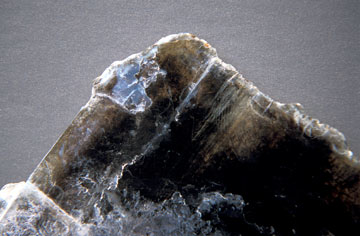|
NEWS NOTES
Mineral resource of the month: mica
| Muscovite mica |
James B. Hedrick, mineral commodity specialist for the U.S. Geological Survey, has compiled the following information on mica, a group of minerals with unique physical properties.
Humans have been using mica for millennia. Mica was first mined in India about 4,000 years ago, where it was used primarily in medicines, and some Hindu physicians still incorporate biotite mica into medicines today. Early civilizations also used mica for decorations, as windows and as surfaces on which to draw or paint. Maya temples were decorated with mica pigments, which were incorporated into the stucco to make it sparkle in the sun. In North America, ancient inhabitants adorned gravesites and burial mounds with animal figures made of mica.
The word “mica” comes from the Latin word micare, meaning to shine or flash, an allusion to mica’s ability to reflect and refract light. “Mica” represents 37 phyllosilicate minerals that have a layered or platy texture. These mica minerals all have a crystalline structure that forms layers that can be split into thin sheets, a physical property called perfect basal cleavage.
Resources of scrap and flake mica are available in granite, pegmatite, schist, clay and placer deposits in many countries, including Brazil, India, Madagascar and Russia. Sheet mica occurs most commonly in pegmatites, a coarse-grained granitic igneous rock that forms under non-equilibrium conditions of temperature and pressure.
The principal micas used in commercial applications are biotite, muscovite and phlogopite. While biotite is generally used in its ground (particle) form as a soil additive, muscovite and phlogopite have applications both in sheet and in ground forms. As sheets, they are used primarily in the electronic and electrical industries, such as in electrical insulators in motors and transformers; window liners of high-pressure boilers, stoves and kerosene heaters; aerospace components in missiles and radar systems; and as insulators in hot water heaters, toasters, hair dryers and curling irons.
Muscovite and phlogopite have both dry- and wet-ground applications. The dry-ground form is particularly useful: It is used to bond, strengthen and fill in the seams between drywall; as a paint additive; as a filler and extender in plastics; in molded electrical insulation; and in roofing shingle coating to prevent sticking. Additionally, dry-ground phlogopite mica is used as an asbestos substitute in automotive brake linings and clutch plates to reduce noise and vibrations and likewise in sound-absorbing insulation for coatings and polymer systems. It is also used in heat shields and insulation from high temperatures and ultraviolet radiation.
Wet-ground mica, which retains the brilliance of its cleavage faces, is used primarily in pearlescent paints by the automotive industry, but its reflective and refractive properties make it an important ingredient in cosmetics as well, from eyeliner and eyeshadow to body glitter, lipstick and nail polish. Lesser amounts of wet-ground mica are used as decorative coatings on brick, concrete, pottery, stucco and tile surfaces.
World production of scrap and flake mica was estimated at 410,000 metric tons in 2006. The major world producers of muscovite scrap and flake mica, in descending order of current production, were the United States (with 110,000 metric tons), Russia, Finland and the Republic of Korea. Canada was the leading phlogopite scrap and flake producer, and Madagascar was the leading phlogopite sheet mica producer. India was the leading producer of muscovite sheet mica.
For more information on mica and other mineral resources, visit: minerals.usgs.gov/minerals.
Links:
Earth Science World Image Bank

 Subscribe
Subscribe



